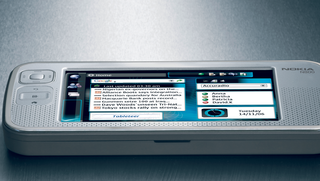
By Nils Faerber
The successor to the Nokia 770, which has just hit the stores, is known as the N800, which makes it one of the Nokia N range of mobile phones. The new kid on the block has inherited many of its predecessor's features, like the display resolution of 800x480 and the well-organized and highly functional keyboard layout. For example, the toggle switch on the top of the device changes the zoom factor in browser mode while changing the volume if you are using the audio player. The manufacturer has enhanced the quality of the product, and it now has a far more exclusive feel about it.
Instead of the flimsy support that was supplied with the Nokia 770, the N800 now has a sturdy folding metal stand (see Figure 1).
The case is slightly wider than previously; the two stereo loudspeakers account for this size difference, along with the tiny, integrated, rotating, and retractable digital camera.
The display is fabulous; the slight jitter in white areas of the 770 color display has more or less completely disappeared on the N800.
Handwriting recognition on the touch screen works fine if you print out every letter, but you need neat handwriting for good results.
If you have a more relaxed style of handwriting, however, you might prefer to use the large (or small) virtual keyboard instead.
Nokia has doubled the memory resources - both the RAM and the internal flash - and added two extension slots into the bargain.
In contrast to the 770, the slots are fully SD compatible; one is located below the battery cover, and the other is on the underside of the device and protected by a small flap.
The device comes with a 128MB Micro SD card and a matching SD adapter. This setup gives you the ability to use SD I/O cards in both slots, as they are normally hidden behind caps (see Figure 2).
While I am talking about inner resources, it is worth noting that Nokia has replaced the CPU with a newer, faster model.
Just like the 770, the CPU has a standard ARM core and a DSP core that handles hardware-based audio and video decoding. A 2.0 standard Bluetooth module by CSR completes the hardware ensemble.
Nokia supplies a new version of its IT OS 2007 software, bora, with this hardware. An updated Maemo SDK [1] is also available. OS 2007 is designed to be compatible with OS 2006 (Mistral) for the most part, and thus with the Nokia 770. Of course, new API functions are not downwardly compatible [2].
OS 2007 removes some of the commonly criticized issues with the previous version. For example, a complete alarm framework can now manage multiple appointments, as evidenced by the clock application, which can store multiple alarms. APIs give other applications access to this service.
The camera brings video telephony to the N800, but unfortunately, just video telephony because the device lacks a photo application.
Besides hands-free telephony, the N800 - like the 770 - supports VoIP over XMPP (Extensible Messaging and Presence Protocol). Within the Linux community, this is more commonly known as Jabber. Also, some have speculated about a Skype client.
The Scandinavian manufacturer has reworked Bluetooth connection handling and adapted the device's behavior to match that of mobile phones. Users can now explicitly choose between visible and invisible modes and even attach a Bluetooth keyboard (e.g., the extremely expensive, folding Nokia SU 8W keyboard). Just as with a mobile phone, you use BT OBEX to send and receive files.
The main applications are known for the most part: Opera 8 with Flashplayer 7, an instant messanger, an email program, an RSS reader, an Internet radio player that supports the M3U and PLS playlists, and a media player. The latter can handle the AAC, AMR, MP2, MP3, Real Audio, WAV, and WMA audio formats. Video is really on the move with support for 3GP, AVI, H.263, MPEG-1, MPEG-4, and Real Video.
The open source community viewed the 770 development department as a kind of extension of its own activities, but the announcement by Aari Jaksi, the Head of Development, that there would never be an official version of OS 2007 for the older 770 upset some users in the community. Nokia does not seem to be that interested in providing free updates for older products. Although this makes economic sense, it is slightly unusual for an open source provider like Nokia. This said, Jaksi recently promised to discuss the issue within the Nokia corporation. Until then, the future looks uncertain for 770 owners.
Despite discussions about the predecessor's sustainability, the hardware and software the new device offers users are indisputably superior to what the 770 offered. The haptics and ergonomics are also praiseworthy. If you need the functionality the N800 gives you and have about US$ 400 to spare, just buy one.
| INFO |
|
[1] Maemo: http://maemo.org
[2] Application compatibility between different Maemo versions: http://maemo.org/downloads/maemo_3_compatibility.html |